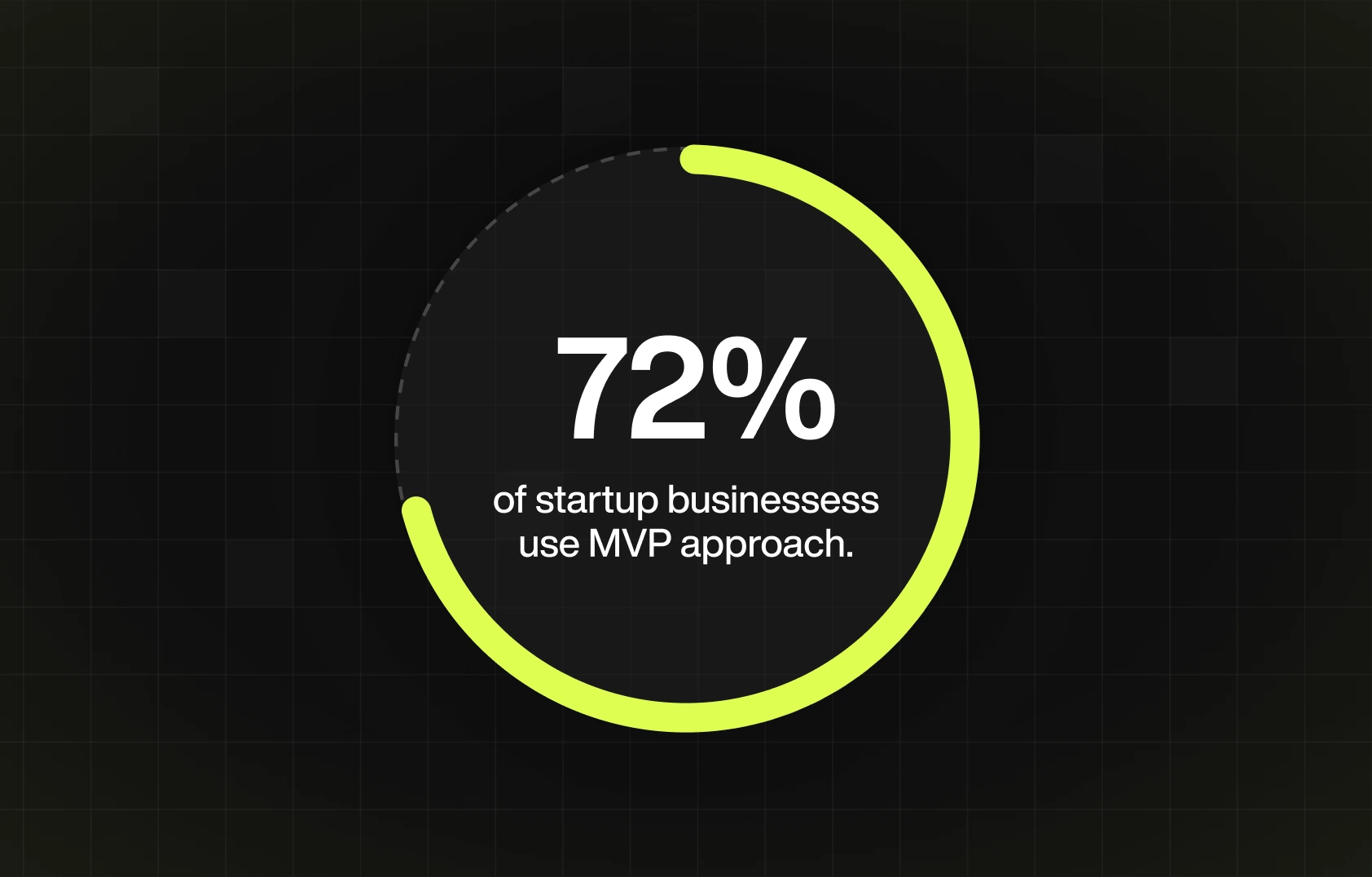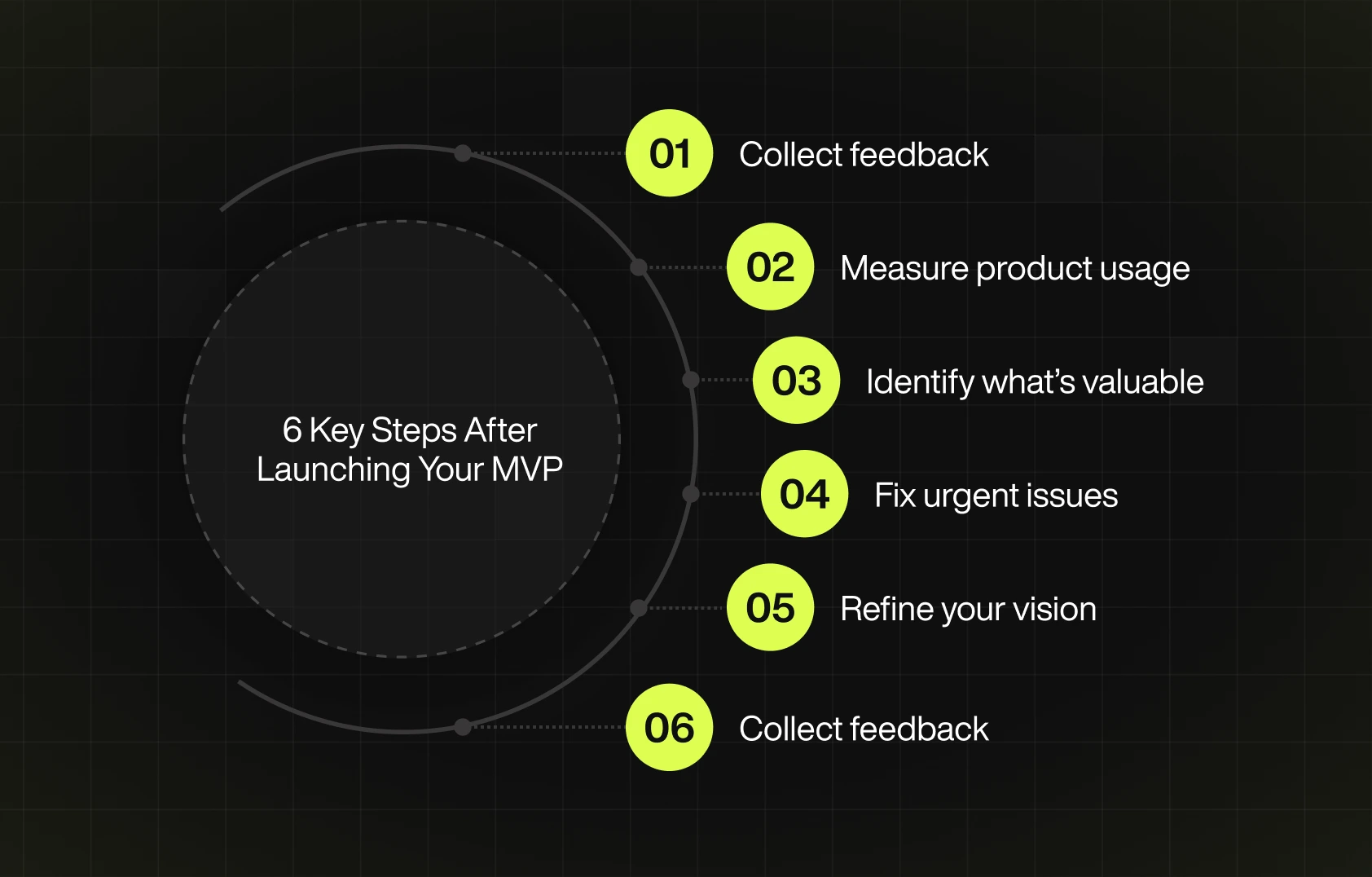Table of content
Summary:
An MVP, or Minimum Viable Product, is the leanest version of your product that includes only the core features. It’s one of the best ways to test whether your idea has real market potential.
- An MVP is a working product with just the core functionality, built to test your idea with real users.
- It’s a strategic tool for validation, not a prototype, and not yet the final product.
- MVP is an ideal solution for startups, new market testing, or attracting early investors.
- Regulated industries or infrastructure-heavy products may require a different approach, so building an MVP is ot always suitable.
- After the MVP is launched, the focus should be on learning, iterating, and refining based on real-world feedback.
What does MVP mean in business?
When it comes to MVP meaning in business, the explanation is quite simple. As a basic version of the product, MVPs are a way to determine how users interact with your idea. It’s a helpful tool when you need to see if there's room for improvement - and where - before launching the final version. Simply put, it’s the best way to validate your idea fast and start attracting customers early. If that sounds interesting to you, our article can show you all about why and how an MVP and business ideas can go hand in hand.
What does MVP stand for in business?
An MVP (Minimum Viable Product) represents the simplest version of your product with only the core features. It’s built to test your idea in the real world as quickly and cost‑effectively as possible, so you can validate your concept. Based on the insights you get from the MVP testing, you can make improvements and avoid investing heavily in features that may not work. At the sme time, it allows you to present your vision in a tangible way to investors, partners, or early customers.
You can build an MVP for almost any product, service, or idea where you need to validate your assumptions before investing further. Besides being a great solution for SaaS platforms, mobile and web apps, as well as software tools, MVP can also be used for:
- Physical products - gadgets, wearables, hardware prototypes.
- Services - subscription services, consulting models, and delivery services.
- Marketplaces - platforms connecting buyers and sellers
- E-commerce - online stores with a limited product range to test demand.
- Content-based products - online courses, membership communities, media platforms.
- Internal tools - solutions for improving company operations or workflows.
MVP meaning in business - a shortcut to real market feedback
MVP is the most efficient and safe way to learn if there’s a market’s interest and demand for what you’re offering. As a low-risk option for your business as well as your wallet, it allows you to test and refine your product. Before investing all you have in an idea, you need to make sure it’s ready to sell - and it’s the exact purpose of a well-thought-out MVP.
When done right, MVP testing allows you to:
- Save money - with MVP, you’re focused on developing basic features, no unnecessary additions,
- Gather valuable insights - it shows how real-world users interact with your product, which, in return, allows you to implement user-centered solutions and adapt the product further to their needs,
- Challenge your assumptions - you can see if your ideas really hold up and avoid costly mistakes down the road,
- Launch fast - it allows you to get your product to the market quickly, even before the final version is ready,
- Secure investments - it’s easier to look for early investor buy-in when you have an idea that is already validated and users that are already interested.
As you can see, an MVP is not just a rough draft (although it’s often mistaken for it). It’s actually a strategic validation tool that helps you test ideas and make informed decisions about the future of your product.
What is an MVP in financial management?
When it comes to the financial aspect, an MVP is a way of starting a business without breaking the bank. It doesn’t come with the expenses of building a full product. Moreover, it focuses only on the essentials and allows you to test key assumptions early to avoid costly mistakes. This lean approach helps businesses allocate resources wisely and adapt quickly as they move forward.
Core ingredients of a business MVP
How is an MVP developed? And how do you know it’s actually ready to go into the real world? First of all, you need to ensure that this version of your product aligns with your strategic goals. In other words, you need to come to a conclusion about the purpose the MVP should serve.
Instead of trying to solve multiple problems at once, your product’s basic version should focus on one key issue that needs solving. Remember, an MVP is meant to deliver just a small set of core functions, and you’ll need to be strategic when choosing the functionality you wish to focus on at the beginning. Competitive analysis or user research can be quite helpful when it comes to feature selection. Many businesses also consider the implementation costs, as well as the time needed for iteration.
In the end, MVPs also need to be testable. It means they should be complete enough for real users to interact with them. At the same time, they need to be structured in a way that allows you to gather measurable feedback. Always keep in mind that they should not consist of half-built features, but become a viable working product that you’ll be able to sell.

What is an example of an MVP? Classic MVP success stories that prove the point
Sometimes the simplest version of an idea is all you need to validate it. These well-known MVPs show how major companies started small, but smart:
- Dropbox and the demo video
Instead of building a full product, Dropbox created a short explainer video showing how the service would work. It attracted thousands of signups overnight. It was all the proof of demand they needed - and they got it before a single line of code was shared.
- Zappos and manual backend
Before building any infrastructure, Zappos founder Nick Swinmurn took photos of shoes at local stores and posted them online. When someone placed an order, he’d buy the shoes and ship them himself. People were willing to buy shoes online, which was a big assumption at the time. However, by fulfilling orders manually, Zappos validated the core idea without investing in logistics or tech. That early proof gave them confidence (and investor traction) to build a real e-commerce platform.
- DoorDash had delivered orders
The founders, Andy Fang, Stanley Tang, and Tony X, started by creating a basic website and personally delivering food in Palo Alto. Initially, there were no drivers and no app. They were just walking the meals door-to-door and proved people wanted local restaurant delivery.
So what’s common for all three of them? Their goal wasn’t to scale or make money right away, but to find out if people actually wanted the product. Each one tested a big assumption in the simplest, quickest way possible, and did so without wasting time or money.
MVP vs. prototype vs. product - know the difference
An MVP acts as a bridge between your prototype and the final product. However, sometimes there is not enough distinction between these terms. To avoid any misunderstanding, we’ve made a simple comparison that shows how these three different product-building stages differ from one another.
When you should (and shouldn’t) build an MVP
Although it may seem like it at first, an MVP is not a magic wand or a one-size-fits-all option. While they can be powerful tools, early-stage product validation solutions don’t make sense in every situation. So, when can MVP accelerate learning, and where can it backfire?
When to Build an MVP
- Testing a new startup idea
It’s always a good choice when you have a concept but need to see if people actually want it. One of the MVP’s main purposes is to validate the idea before investing in full development.
- Entering a new market
If you plan on expanding into a new audience or geography, it’s a good tool to learn how the new users behave.
- Solving a specific pain point
MVPs can also be used to improve user experience. When you’ve identified a clear user problem and want to test a solution before building out extras,
- Getting investor or stakeholder buy-in
A basic working version shows traction and can help secure funding or internal support.
When Not to Build an MVP
- Heavily regulated industries
In areas like healthcare, finance, or defense, launching a half-ready product may not be legally (or ethically) possible.
- Products requiring full infrastructure
Some ideas (like smart cities tech, hardware systems) can’t function meaningfully without a complete backend. It makes MVPs unrealistic and, therefore, unnecessary.
- Brand-critical launches
When first impressions are everything, a basic-feature version, such as MVP, may hurt more than help.
What happens after MVP? It’s all about the learning
Once your MVP is out in the real world, the real work begins. Your goal should be learning as much as you can from every user interaction or metric collected. After your MVP is launched, you can start validating your assumptions and figuring out what’s resonating with your audience - and what’s not. The key is to use these insights to make smarter product decisions.
Iteration is what turns a minimal product into a valuable one. And while design plays a big role in that evolution, right now it’s about strategy and learning. Think of this stage as building a foundation - the clearer your understanding of users and their needs, the stronger your next steps will be.

Final thoughts - you don’t need a full product to start a business
Building a successful product doesn’t mean launching with every feature you’ve ever imagined. In fact, starting small is often the smartest path. It’s a great way to reduce risks and save money, all while building a product that truly meets user needs. MVP in business can help you learn as you go, so your vision can evolve in the right direction.
If you’re stuck and don’t know where to start, we can help. At Devolfs, we help startups and scaleups start their businesses with the help of MVPs that launch fast and attract users. Make sure to contact us if you’re interested in collaboration.





%201.svg)






